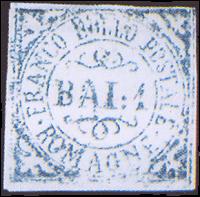
Fig. 1: the 1 Bajocco essay
(from "Catalogo Sassone Specializzato", ed. 2001)
The issue - general introduction
The first
postage stamps issue for the Romagne territories goes back to September 1st
1859.
The first question that comes natural is "why the issue values are in Bajocchi,
when there was a huge effort to cancel all the signs of the Pontifical dominion?".
The answer has been already given indirectly in the historic introduction.
The Italian Lira was introduced with a Decree dated June 28th 1859, and it became
official currency in November 1st.
The problem was that in the Romagne the Roman stamps got used up very soon and
therefore a new issue was needed. For various historical-political and of "convenience"
reasons (being the situations in the territories quite chaotic) the stamps could
not be the Sardinian ones and therefore the solution chosen was simple and somehow
home made. In addition the only circulating currency in the day by day reality
was the Roman Bajocco leaving not so many choices to choose in between!
And so, "on 30th August 1859 appeared a decree signed by Cipriani, Governor
General, authorising the issue of a new series of stamps" (Donald S.
Patton, "The Romagna", March 1853).
The minting die engraver is unknown. It was of the type with movable value.
The subject, very simple, is a central rectangle where the number with the value
is inserted with under it the label "BAI:"; all around there is a
double rectangular frame where there are inserted the labels "FRANCO"
on the left, "BOLLO" on top, "POSTALE" on the right and
"ROMAGNE" below. In the corners there are 4 ornamental decorations.
By sure we cannot say that these stamps are nice looking, on the opposite! Damilano
define them "functional": an elegant word not to say that they
were really ugly!
The matrix
preparation was done by Fratelli Amoretti foundry from Bologna.
The printing was done with the typographic system on colored paper, without
watermark, of average thickness (the Half and the 8 Bajocchi have thicker paper)
probably from a local manufacturer. The responsibility of the printing was given
at the beginning to the "Tipografia Governativa Della Volpe e Del Sassi"
from Bologna" and later on to the Tinti & Merlani company. The paper
was very constant in colors and eventual shades are to be attributed to the
gum action and to the sun exposure; only the 1 Baj value presents itself in
two different color shades.
The pieces were printed in sheets of 120 parts each, divided in two groups one
on top of the other of 60 pieces ((6 rows by 10 columns) separated by an horizontal
inter-space of about 8 mm, using matrixes obtained by electrolysis from the
original minting die, probably made of copper. The stamps are separated from
each other by thin typographic lines: the vertical ones are tall as 6 stamps,
while the horizontal ones are interrupted under each stamp; the pieces of the
first and of the last row don't have the thin lines respectively over and under.
There are the values that were printed:
|
Half
Bajocco
|
Straw
yellow
|
|
1 Bajocco
|
Brown
gray
|
|
2 Bajocchi
|
Yellow
|
|
3 Bajocchi
|
Deep
green
|
|
4 Bajocchi
|
Tawny
|
|
5 Bajocchi
|
Violet
|
|
6 Bajocchi
|
Gren
yellow
|
|
8 Bajocchi
|
Pink
|
|
20 Bajocchi
|
Bluish
gray
|
Not all the values were
printed at the same time: the 4 Baj is found used only starting September 4th,
the 6 Baj from September 22nd, 8 Baj from September 3rd and the 20 Baj from
September 5th.
Between the main varieties there are some printing defects due to stereotype
imperfections. Very rare are also the mixed postage of various type the use
of the split ones (some very rare).
Some essays of several values (2, 3, 4, 6, 8, 20 Baj) were printed both in gray
on white paper and on colored paper but with colors different from the ones
of the stamps later on issued.
A note on the side should be made for an essay of 1 Baiocco, with drawing totally
different from the stamps later adopted: it is printed in blue on very thin
white paper or on yellowish thick paper. Its origin is not known but it is now
accepted by everybody as a real essay (Fig. 1).

Fig. 1:
the 1 Bajocco essay
(from "Catalogo Sassone Specializzato", ed. 2001)
The stamps were valid up to January 31st 1860, even if their use was tolerated up to February end, due the Sardinia stamps absolutely not enough to cover the needs.
Of the various values the total quantity printed is known and it's the following:
|
Half
baj
|
78.000
|
|
1 baj
|
125.400
|
|
2 baj
|
93.000
|
|
3 baj
|
60.000
|
|
4 baj
|
90.000
|
|
5 baj
|
46.800
|
|
6 baj
|
15.000
|
|
8 baj
|
21.000
|
|
20 baj
|
6.000
|